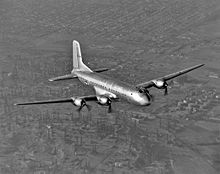Douglas C-74
| Douglas C-74 Globemaster | |
|---|---|
 A C-74 in Long Beach, California (USA) |
|
| Type: | Transport plane |
| Design country: | |
| Manufacturer: | |
| First flight: |
September 5, 1945 |
| Commissioning: |
1946 |
| Production time: |
1945 to 1946 |
| Number of pieces: |
14th |
The Douglas C-74 Globemaster was developed from 1942 at the request of the United States Army Air Forces for a transport aircraft for transatlantic traffic. The machine was powered by four piston engines and did not have a pressurized cabin .
development
At the time of its maiden flight, the Globemaster was the heaviest land aircraft in the world, with a maximum takeoff weight of 78 tons. With its four Pratt & Whitney Wasp Major star engines, it was able to transport 125 fully equipped soldiers.
As a special feature, it received the same cockpit as the Douglas XB-42 with separate hoods for pilot and co-pilot, which was not particularly popular with the crews and earned it the nickname Bug-Eye . That is why the cockpit was later fitted with a conventional canopy. The machine also got more powerful engines over time.
Since the first flight did not take place until September 5, 1945 and the machine was too late for use in World War II , production was stopped in January 1946 after only 14 machines. The planning for a civil version was also finished.
During the Berlin Airlift , which was supported by the Americans with C-74, C-54 and C-47 , it became clear that a heavy strategic transporter was needed. A C-74 was then converted into a prototype for the C-124 Globemaster II , which had the same wings and engines as the first Globemaster, but a much larger fuselage.
The C-124 replaced the Globemaster I very quickly, so the last C-74s were scrapped in the 1960s and 1970s.
production
Acceptance of the C-74 by the USAAF:
| Type | 1945 | 1946 | 1947 | TOTAL |
|---|---|---|---|---|
| C-74 | 1 | 5 | 7th | 13 |
The 14th aircraft was a static rupture cell. In 1952 a C-74 was converted into the C-124 prototype. The last eleven aircraft were retired in 1957.
Technical specifications

| Parameter | Data |
|---|---|
| crew | 3 |
| length | 37.85 m |
| span | 52.81 m |
| height | 13.34 m |
| Empty weight | 39,087 kg |
| maximum takeoff weight | 78,000 kg |
| Engines | 4 × radial engine Pratt & Whitney R-4360 -49 with 3,296 HP (2,424 kW) each |
| Top speed | 528 km / h |
| Range | 5,470 km |
| Service ceiling | 6,490 m |
| Rate of climb | 794 m / min |
See also
literature
- Nicholas M. Williams: Bug-eyed Monster - the Douglas Model 415A the first Globemaster and DC-7. In: AIR Enthusiast No. 60, November / December 1995, pp. 40-53.
Web links
Individual evidence
- ↑ Statistical Digest of the USAF 1946. pp. 94 ff; 1947, p. 115.
- ↑ Statistical Digest of the USAF 1952 and 1957. Table "US Aircraft Gains and Losses"